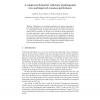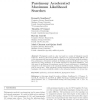54 search results - page 2 / 11 » Improved Phylogenetic Motif Detection Using Parsimony |
BMCBI
2005
13 years 4 months ago
2005
Background: In a previous report (La et al., Proteins, 2005), we have demonstrated that the identification of phylogenetic motifs, protein sequence fragments conserving the overal...
WABI
2005
Springer
13 years 9 months ago
2005
Springer
Phylogenetic tree searching algorithms often produce thousands of trees which biologists save in Newick format in order to perform further analysis. Unfortunately, Newick is neithe...
BMCBI
2007
13 years 4 months ago
2007
Background: Unraveling the mechanisms that regulate gene expression is a major challenge in biology. An important task in this challenge is to identify regulatory elements, especi...
BMCBI
2006
13 years 4 months ago
2006
Background: The discovery of cis-regulatory motifs still remains a challenging task even though the number of sequenced genomes is constantly growing. Computational analyses using...
IJCBDD
2008
13 years 4 months ago
2008
: Phylogenetic search is a key tool used in a variety of biological research endeavors. However, this search problem is known to be computationally difficult, due to the astronomic...


